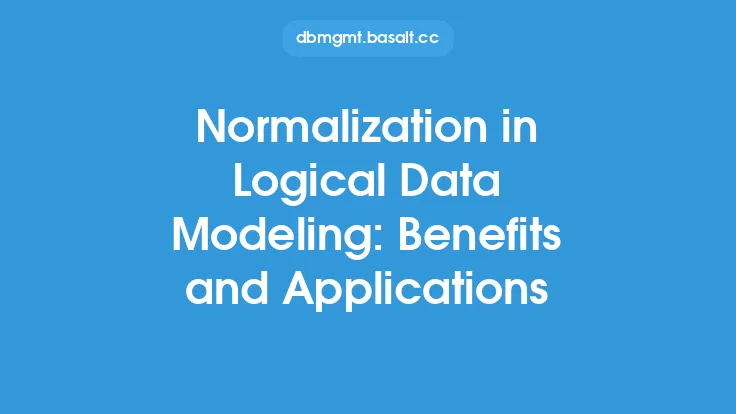Logical data modeling is a crucial aspect of data management that involves creating a conceptual representation of an organization's data assets. It provides a framework for understanding the relationships between different data entities, attributes, and relationships, which is essential for effective data governance. Data governance, on the other hand, refers to the set of policies, procedures, and standards that ensure the quality, security, and integrity of an organization's data. In this article, we will explore the connection between logical data modeling and data governance, and how they can be used together to create a robust and sustainable data management framework.
Introduction to Data Governance
Data governance is a critical component of any data management strategy. It involves establishing policies, procedures, and standards for managing an organization's data assets, including data quality, security, and integrity. Effective data governance ensures that data is accurate, complete, and consistent, and that it is properly secured and protected from unauthorized access or misuse. Data governance also involves establishing roles and responsibilities for data management, including data ownership, stewardship, and custodianship. By establishing a robust data governance framework, organizations can ensure that their data is reliable, trustworthy, and compliant with regulatory requirements.
The Role of Logical Data Modeling in Data Governance
Logical data modeling plays a critical role in data governance by providing a conceptual representation of an organization's data assets. A logical data model provides a detailed description of the data entities, attributes, and relationships that are relevant to the organization, which is essential for understanding the data landscape. By creating a logical data model, organizations can identify data gaps, inconsistencies, and redundancies, and develop strategies for improving data quality and integrity. Logical data modeling also provides a framework for data standardization, which is essential for ensuring that data is consistent and comparable across different systems and applications.
Data Governance and Data Quality
Data quality is a critical aspect of data governance, and logical data modeling plays a key role in ensuring that data is accurate, complete, and consistent. By creating a logical data model, organizations can identify data quality issues, such as data inconsistencies, duplicates, and errors, and develop strategies for improving data quality. Data governance policies and procedures can be established to ensure that data is properly validated, verified, and cleansed, and that data quality metrics are established to measure data quality. By combining logical data modeling with data governance, organizations can ensure that their data is reliable, trustworthy, and fit for purpose.
Data Security and Access Control
Data security and access control are critical components of data governance, and logical data modeling can play a key role in ensuring that data is properly secured and protected. By creating a logical data model, organizations can identify sensitive data entities and attributes, and develop strategies for securing and protecting them. Data governance policies and procedures can be established to ensure that data is properly encrypted, and that access to sensitive data is restricted to authorized personnel. Logical data modeling can also be used to identify data relationships and dependencies, which is essential for ensuring that data is properly secured and protected.
Data Lineage and Provenance
Data lineage and provenance are critical aspects of data governance, and logical data modeling can play a key role in tracking the origin, movement, and transformation of data. By creating a logical data model, organizations can identify data sources, transformations, and destinations, and develop strategies for tracking data lineage and provenance. Data governance policies and procedures can be established to ensure that data is properly documented, and that data lineage and provenance are properly tracked and recorded. By combining logical data modeling with data governance, organizations can ensure that their data is transparent, accountable, and trustworthy.
Metadata Management
Metadata management is a critical component of data governance, and logical data modeling can play a key role in managing metadata. By creating a logical data model, organizations can identify metadata entities and attributes, and develop strategies for managing metadata. Data governance policies and procedures can be established to ensure that metadata is properly documented, and that metadata is properly managed and maintained. Logical data modeling can also be used to identify metadata relationships and dependencies, which is essential for ensuring that metadata is properly managed and maintained.
Best Practices for Implementing Logical Data Modeling and Data Governance
Implementing logical data modeling and data governance requires a structured approach that involves several best practices. These include establishing a data governance framework, creating a logical data model, establishing data quality metrics, implementing data security and access control, tracking data lineage and provenance, and managing metadata. Organizations should also establish roles and responsibilities for data management, including data ownership, stewardship, and custodianship. By following these best practices, organizations can ensure that their data is reliable, trustworthy, and compliant with regulatory requirements.
Conclusion
Logical data modeling and data governance are closely connected, and together they provide a robust and sustainable framework for managing an organization's data assets. By creating a logical data model, organizations can identify data gaps, inconsistencies, and redundancies, and develop strategies for improving data quality and integrity. Data governance policies and procedures can be established to ensure that data is properly secured, protected, and managed, and that data quality metrics are established to measure data quality. By combining logical data modeling with data governance, organizations can ensure that their data is reliable, trustworthy, and fit for purpose, and that they are compliant with regulatory requirements.





